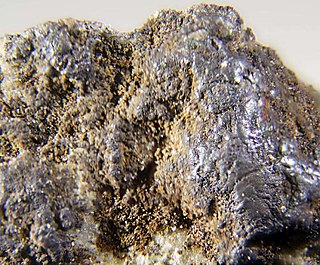 W
WBiehlite is an exceptionally rare mineral, an antimony arsenic bearing molybdate with formula [(Sb,As)O]2MoO4. It comes from Tsumeb.
 W
WFerrimolybdite is a hydrous iron molybdate mineral with formula: Fe3+2(MoO4)3·8(H2O) or Fe3+2(MoO4)3·n(H2O). It forms coatings and radial aggregates of soft yellow needles which crystallize in the orthorhombic system.
 W
WHemusite is a very rare isometric gray mineral containing copper, molybdenum, sulfur, and tin with chemical formula Cu6SnMoS8. It was discovered by Bulgarian mineralogist Georgi Terziev in 1963. He also described it and named it after Haemus, the ancient name of Stara planina (Balkan) mountains in Europe. The type locality is Chelopech copper ore deposit, Bulgaria. Later tiny deposits of hemusite were found in Ozernovskoe deposit, Kamchatka, Russia; Kawazu mine, Rendaiji, Shimoda city, Chūbu region, Honshu Island, Japan; Iriki mine, Iriki, Satsuma-gun, Kagoshima Prefecture, Kyushu Region, Japan; Kochbulak deposit, Tashkent, Uzbekistan. Hemusite occurs as rounded isometric grains and aggregates usually about 0.05 mm in diameter and in association with enargite, luzonite, colusite, stannoidite, renierite, tennantite, chalcopyrite, pyrite, and other minerals.
 W
WKamiokite is an iron-molybdenum oxide mineral with the chemical formula Fe2Mo3O8. The name kamiokite is derived from the locality, the Kamioka mine in Gifu Prefecture, Japan, where this mineral was first discovered in 1975.
 W
WLindgrenite is an uncommon copper molybdate mineral with formula: Cu3(MoO4)2(OH)2. It occurs as tabular to platey monoclinic green to yellow green crystals.
 W
WMolybdenite is a mineral of molybdenum disulfide, MoS2. Similar in appearance and feel to graphite, molybdenite has a lubricating effect that is a consequence of its layered structure. The atomic structure consists of a sheet of molybdenum atoms sandwiched between sheets of sulfur atoms. The Mo-S bonds are strong, but the interaction between the sulfur atoms at the top and bottom of separate sandwich-like tri-layers is weak, resulting in easy slippage as well as cleavage planes. Molybdenite crystallizes in the hexagonal crystal system as the common polytype 2H and also in the trigonal system as the 3R polytype.
 W
WMolybdite is the naturally occurring mineral form of molybdenum trioxide MoO3. It occurs as yellow to greenish needles and crystallizes in the orthorhombic crystal system.
 W
WPowellite is a calcium molybdate mineral with formula CaMoO4. Powellite crystallizes with tetragonal - dipyramidal crystal structure as transparent adamantine blue, greenish brown, yellow to grey typically anhedral forms. It exhibits distinct cleavage and has a brittle to conchoidal fracture. It has a Mohs hardness of 3.5 to 4 and a specific gravity of 4.25. It forms a solid solution series with scheelite (calcium tungstate, CaWO4). It has refractive index values of nω=1.974 and nε=1.984.
 W
WWulfenite is a lead molybdate mineral with the formula PbMoO4. It can be most often found as thin tabular crystals with a bright orange-red to yellow-orange color, sometimes brown, although the color can be highly variable. In its yellow form it is sometimes called "yellow lead ore".